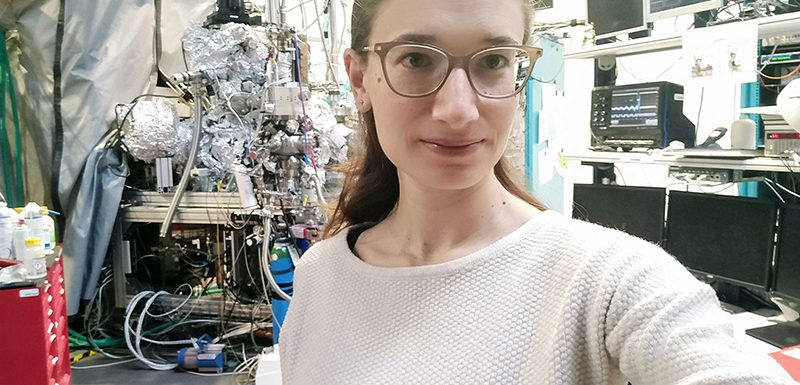
At BESSY II, we are operating some 50 beamlines, each of which offers the latest methods in spectroscopy and microscopy.
Each beamline has a dedicated beamline scientist, who not only manages all the projects on the beamline and knows its every secret, but also works with local and visiting scientists to get the best results out of the beam and its instruments for every specific research question they have. Without the beamline scientists, much of the science at BESSY II could never happen.
But who are they? What makes a good beamline scientist and where do they come from? In this little series you are going to find out. Today we introduce Erika Giangrisostomi who works at the PM4 beamline.
What’s the name of your beamline and what’s it like? For which research applications is this beamline especially suitable?
The beamline is called PM4. As a dipole beamline, it provides a moderate photon flux over a wide range of photon energies, in our case in the vacuum ultraviolet/soft X-ray regime. It serves the fixed end-station called LowDosePES. As the name suggests, its specialty is photoemission spectroscopy (PES) at low X-ray dose.
A low X-ray dose is required for the investigation of samples which suffer from radiation-induced damage, an example being organic materials. We are able to measure low-dose PES thanks, on the one hand, to an efficient angular-resolved time-of-flight analyzer (ArTOF) as our electron spectrometer and, on the other hand, to a very fast mechanical chopper, which cuts down the beam intensity by extracting a single pulse out of a train of more than 300 pulses circulating in the BESSY ring under the standard operation mode. Both, the ArTOF and the MHz pulse selector, are developments fostered by our institute in the framework of external collaborations with Uppsala University and Forschungszentrum Jülich, respectively.
What’s your background, scientifically? How did you get to be a beamline scientist?
I did my studies in Physics in Italy (I am Italian), got my Bachelor and Master at the University of Camerino and my PhD at the University of Trieste. As a PhD fellow, I have contributed to the development of a beamline and to the realization of pilot experiments at the free electron laser FERMI in Trieste, which was starting its commissioning phase right at that time. It has been a truly exciting experience for me and a good training ground that has earned me a postdoc position at BESSY.
“Where else could I get to experience so much frustration and so much fun? Beamline work is greatly generous with both.”
What is your work as a beamline scientist?
(Or: What are you doing “all day”?)
Weekly we welcome a new user group at our beamline and work to ensure that everything is optimally setup for them to perform the planned experiment. We then remain available to intervene when any technical issue pops up or, if the users are open to that, to discuss into the merits of the scientific results. Not all requests can always be accommodated, but we retain their inputs to inform our decisions on how to improve the capabilities of our setup on a longer term.
What is your biggest challenge in working with the beamline?
What is the most rewarding part?
A successful experiment at a synchrotron is the result of an incredibly large number of big and small pieces of equipment working in concert. Therefore, chances are high that, at any moment, one or another component needs some sort of fix. As many instruments at our beamline date years and years back, this is even more so.
But of course, I am happy when our efforts can serve the success of an experiment and with that enable the progress of a research field.
What are you working on at the moment?
We are planning several upgrades, spanning from the procurement of a new manipulator with state-of-the-art functionalities, to the construction of a noise insulating hutch, and some major re-design of the beamline in view of the upcoming BESSY VSR development.
In parallel, I am pushing forward my own scientific research projects and looking out for potential collaborators to broaden our user community.
What have you always wanted to tell people about beamline work?
If they would have told me after my studies that I would be working as a beamline scientist, I would have not believed it. But now I have a hard time to even imagine myself in another working environment. Well, sometimes I actually dream of having unconstrained time to sit at my desk quietly and contemplate the marvels of nature through the scientific questions that it poses to us… But – back to reality – where else could I get to experience so much frustration and so much fun? Beamline work is greatly generous with both.
(kh)
